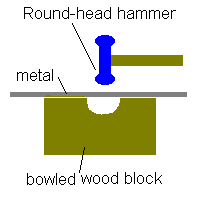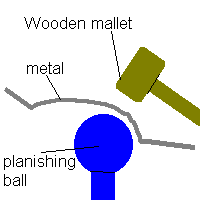
|

|
|
Armour Bowling or Raising By: Scott J. Swindell House of Bacchus Bowling is one of the most critical and important skills in armouring. It is the technique of creating a domed shape in the metal. Pieces that require bowling are elbow cops (couters), knee cops (poleyns), helms, and many more subtle places. This of course could be done by machine, but if you are going to make armour, you might as well do it the authentic way: by hand. |
| Step 1: | 
|
Place the metal to be bowled over a wood block with a concave hole
in it. The hole can vary in size depending on the size of the piece
you are working on. I, however, find that if it is about 1/2 to 3/4
deep as it is wide, it works well. You will be using a metal hammer
with a rounded head. A car body hammer, works well, but ball-peen
hammers are usually too spherical to give an attractive bowl.
|
| Step 2: | 
|
With light strokes, start in the center of the area to be bowled,
and strike the metal. This will start to create a concave indention,
the more you hammer. Gradually work your way out from the center to the
edges of the desired bowl, using light, even strokes. Continue this
process, working from the center, outward until the bowl is roughly
the desired shape. As with all techniques in armouring, it is a good
idea to mark the area you intend to work with on the metal BEFORE you begin.
|
| Step 3: | 
|
Now that you have a concave piece of metal of the desired shape,
you will find that there are many hammer marks in it. To finish the
piece, you will need to smooth out the hammer marks using a process
known as planishing. For this, you will need a hardwood mallet, and
a spherical steel ball, or other hard metal. As a variation, you may
use a flathead metal hammer, and a hardwood planishing ball.
|
| Step 4: | 
|
Place the metal on the ball, and strike with the hammer perpendicular to the metal.
This will flatten hammer marks and other irregularities.
Continue this process until the surface is as smooth as you desire it.
|